15 donation request letter templates and how to write your own

Your organization depends on the goodwill of its donor base. According to the National Philanthropic Trust, Americans generously donated nearly $600 billion in 2024 alone — but how you ask for donations plays a major role in how well you can tap into supporters’ desire to make an impact.
A well-crafted fundraising appeal or donation request letter is a relatively straightforward way to invite donors to make a donation and foster the relationships you need to sustain your organization.
In this blog, we’ll break down the essential elements of a successful appeal to guide your donation request process. Plus, you’ll get access to 15 free donation request letter templates to help you write letters that get results.
What is a donation request letter?
A donation request letter is a written request for donations to an organization. There are several types of letters you can send, depending on factors like:
- The nature of your organization
- Who you’re asking
- What kinds and amounts of donations you need
- The frequency of donations you’re requesting
- The reasons you need donations
- Whether you’re requesting donations via mail or online
Compared to a sponsorship letter, donation requests may seek smaller donations or contributions from a higher volume of donors. Both types of requests aim to connect with prospective donors and build meaningful relationships to support your organization’s mission.
How to write a donation request letter
The key to writing a successful donation request is personalization. By tailoring your letter to each potential donor, you can appeal for their support in a way that resonates with them.
Whether you’re starting from scratch or editing a template, make sure you follow best practices for writing a donation request letter.
![A donation request letter example highlighting essential elements of an effective fundraising appeal.]](https://www.bonterratech.com/wp-content/uploads/2025/04/effective-donation-request-letter.png)
1. Plan your letter structure
When you write a donation request, make sure to include all the information and context a potential donor would want to know. It’s also important to structure your letter in a clear, compelling way.
Essential components of any donation request letter include:
- An engaging subject line: Keep your message concise, but appeal to recipients’ interests and curiosity to encourage engagement.
- A personalized greeting: Personalize each letter with the recipient’s name and relevant details, such as recent involvement or donations.
- Your organization’s information: Include your organization’s name and address, as well as how recipients can contact you.
- A description of your mission: Showcase your strengths by incorporating data into a story that allows donors to connect emotionally with your purpose.
- Why you’re seeking donations: Clearly explain the specific initiative, event, or operation in need of funding to provide context.
- Suggested donation amounts: Eliminate guesswork by offering specific giving tiers or suggested amounts for your audience.
- How donations will impact your work: Illustrate how a donor’s contribution translates into concrete results for your beneficiaries (e.g., “$50 feeds a family for a week”).
- A clear call-to-action: Provide clear instructions and flexible options — such as an online giving form or a QR code for mobile giving. One-click donations can also reduce decision fatigue and make donating as easy as possible.
- A sincere expression of gratitude: Thank recipients in advance for their time and consideration to foster a positive ongoing relationship.
Ultimately, you should strive to write a letter that is easy to read and understand. Make sure you convey the importance of your mission, as well as your sincere need and appreciation for donations.
2. Make it clear and personal
How you present your fundraising appeal is just as important as the message itself. If your copy is concise, easy to read, and personal, donors are more likely to read the entire letter and reach the call to action.
To improve readability, try these tips:
- Keep paragraphs short.
- Format lists with bullet points.
- Add relevant images to illustrate the copy and break up text.
- Use bold and italics for emphasis where appropriate.
- Keep your document under two pages long.
- Check for spelling or grammar errors.
- Ask another staff member to review the content and format.
Focus on building a human connection with your letter. Donors respond better when they are seen as individuals, not just funding sources. Note each supporter’s preferred name, title, and pronouns in your donor database to ensure you address them appropriately.
This personal touch should also extend to who signs the letter. While an executive director or board chair adds credibility for formal appeals, they aren’t always the right choice. If your organization acquired a major donor through a personal connection, it may be more effective to have the letter come from that person.
3. Deliver and track your letters
The above tips primarily apply to direct mail fundraising appeals, which some donors prefer. For those who would rather receive emails or interact with your organization online, you should adjust your messaging strategy to meet them where they are.
Fortunately, you can easily apply and repurpose direct mail donation requests to suit digital channels:
- Email: Reformat your letter to an email template, trim down the content to be more concise, and include a link to your online donation page as your call to action.
- Website: Publish the success stories and impact data from your letter as a news update or blog article to reach more donors.
- Social media: Share key statistics as graphics and post emotional story highlights to engage followers and direct them to your online donation page.
Once you start sending out donation request letters or posting appeals online, you should collect and analyze performance data to inform future outreach efforts. Some of the most important nonprofit organization KPIs to track are:
| Response rate | Track the percentage of recipients who donated to gauge how well your messaging resonated. |
| Demographics | Analyze donor age, location, and giving history to understand which audience segments most align with your mission. |
| Total funds raised | Calculate total donation amounts and average gift size to measure the success of the campaign across channels. |
| Channel effectiveness | Compare direct mail, email, and social media results to determine which platforms were most effective. |
Segmenting your donors, tracking response rates, and calculating total donation amounts will give you valuable insights into your fundraising strategy so you can continue improving how you engage with your donor base.
Using the right fundraising software can simplify your data organization and critical analysis. Bonterra offers software solutions for donor management, email marketing, reporting, and more — all in a robust nonprofit CRM.
15 customizable sample donation request letters
Writing donation requests from scratch can be intimidating, and the process can take more time and effort than ideal. Instead, you can start by modifying a donation request letter template for nonprofit organizations.
We’ve created 15 free sample letters asking for donations that you can download and customize. Tailoring these templates to your audience and your organization’s needs can save you time and allow you to focus on personalization to build stronger connections with your donors.
1. General donation request letter
A general request for donations can be a flexible tool for virtually any kind of fundraising initiative. While versatile, general donation request letters can seem generic without enough personalization.
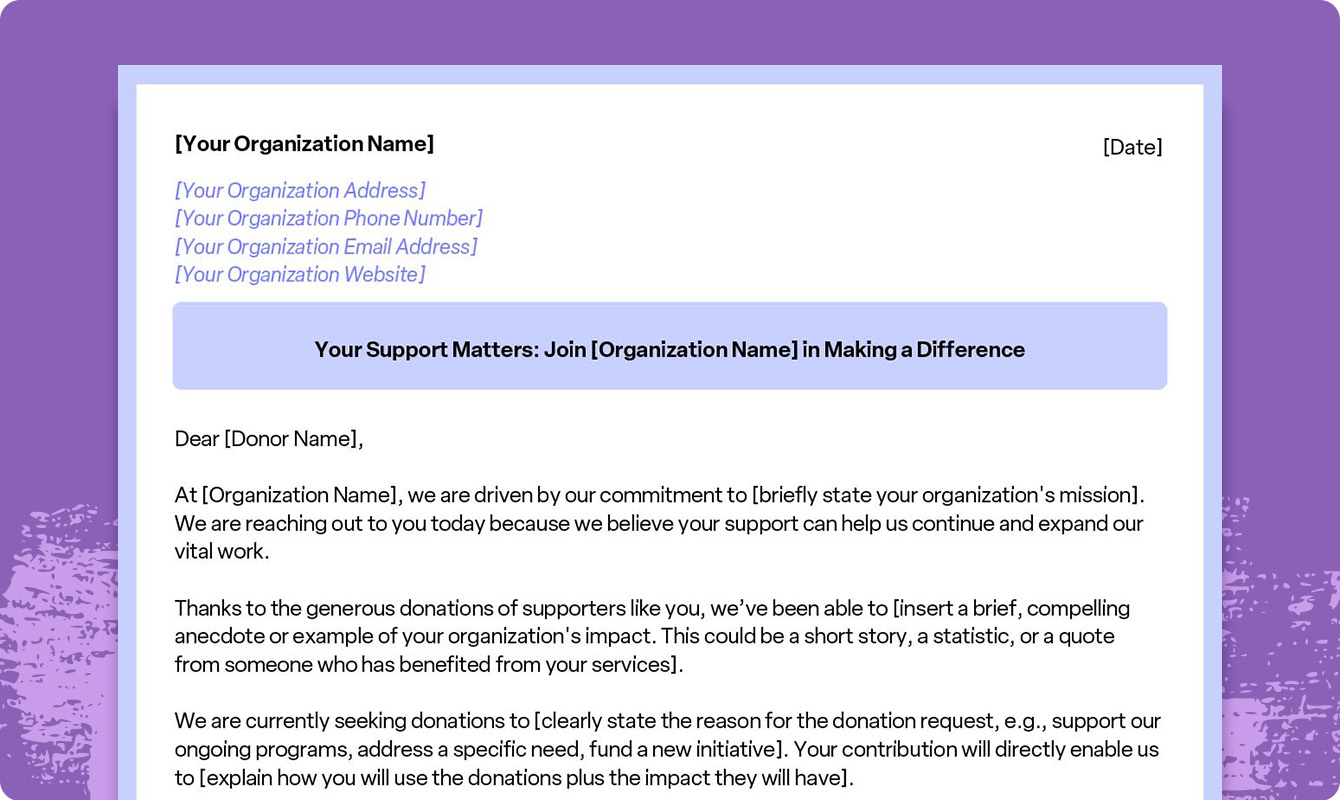
Including anecdotes and examples of your organization’s impact, as well as specific details regarding why you’re asking for donations at this time, can help you connect with potential donors and help them understand how they can help your organization achieve its mission.
2. New donor request letter
Some donors may not feel like their contributions make a difference, but individual donations add up. Even if you have a loyal donor base, seeking new donors is a crucial part of fundraising.
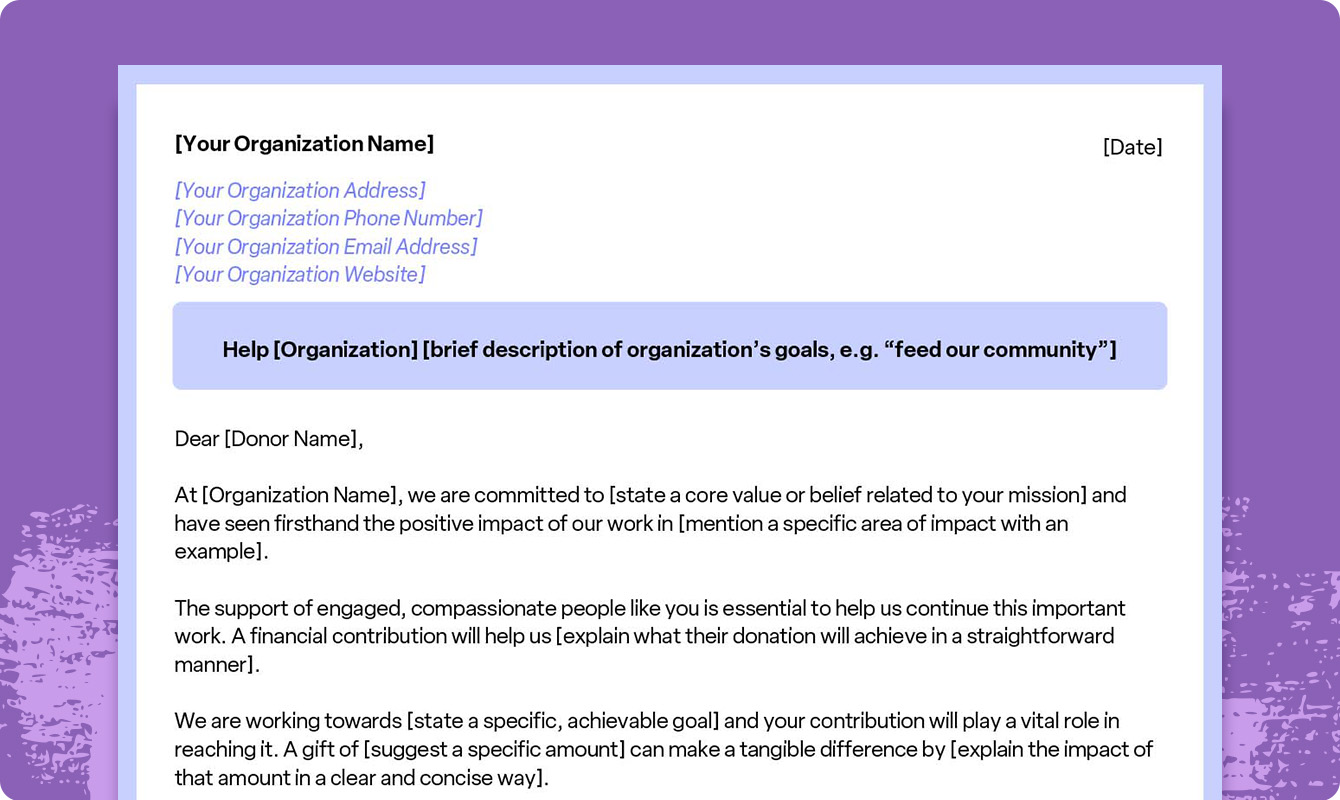
When requesting first-time donations, try to connect with potential donors with personalized messaging. Acknowledge recipients’ connection to your organization, whether that’s attending events, following you on social media, or subscribing to your newsletter.
3. Current and past donor request letter
Reaching out to individuals who have donated to your organization in the past is a great way to encourage additional or recurring contributions.
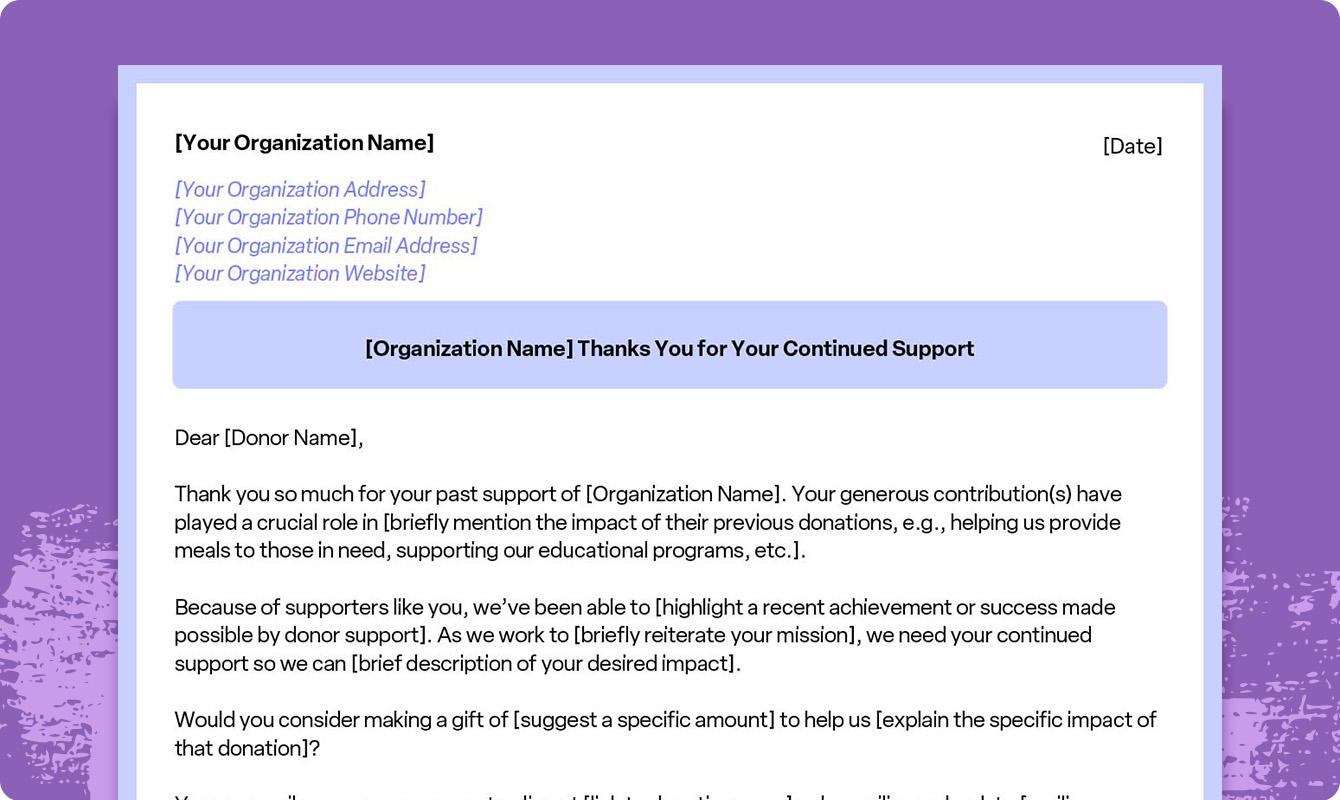
By expressing gratitude for their previous donations and explaining how they directly support your mission, you can boost donor retention and foster more meaningful relationships.
4. Corporate donation request letter
Corporate contributions can drastically affect your organization’s impact by directly supporting your primary initiatives. Partnering with larger businesses, especially as part of their corporate social responsibility (CSR) program, can be mutually beneficial.

When writing a letter asking for donations from businesses, focus on how a partnership could benefit them, from increasing brand awareness to improving employee engagement. Highlight the advantages of supporting your organization in your request for donations, as well as how their contributions will directly impact your mission.
5. Small business donation request letter
Compared to corporate requests, seeking donations from small businesses often requires more of a personal, empathetic approach. Rather than prioritizing bottom lines and measurable results, you may have more success focusing on emotional ties and local impact.
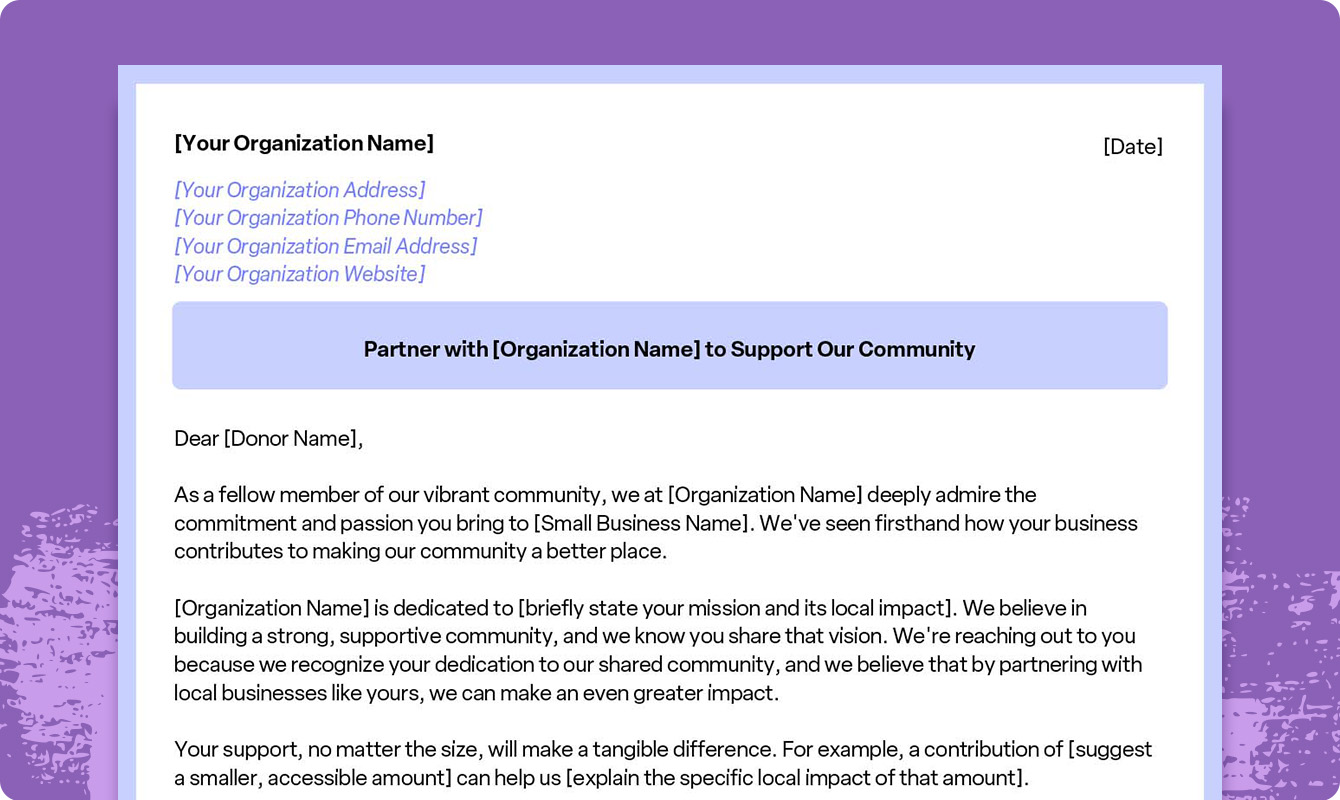
Small businesses may not be able to donate as much as larger corporations, but their support can help unite your community.
6. Event donation request letter
If your organization is hosting a gala, auction, or other fundraising event, you’ll likely need to secure funding to make it happen. Write an engaging donation request that highlights event specifics, including:
- Who you hope will attend
- Why it’s happening
- What your goals are
- When you’re hosting it
- Where it will be held
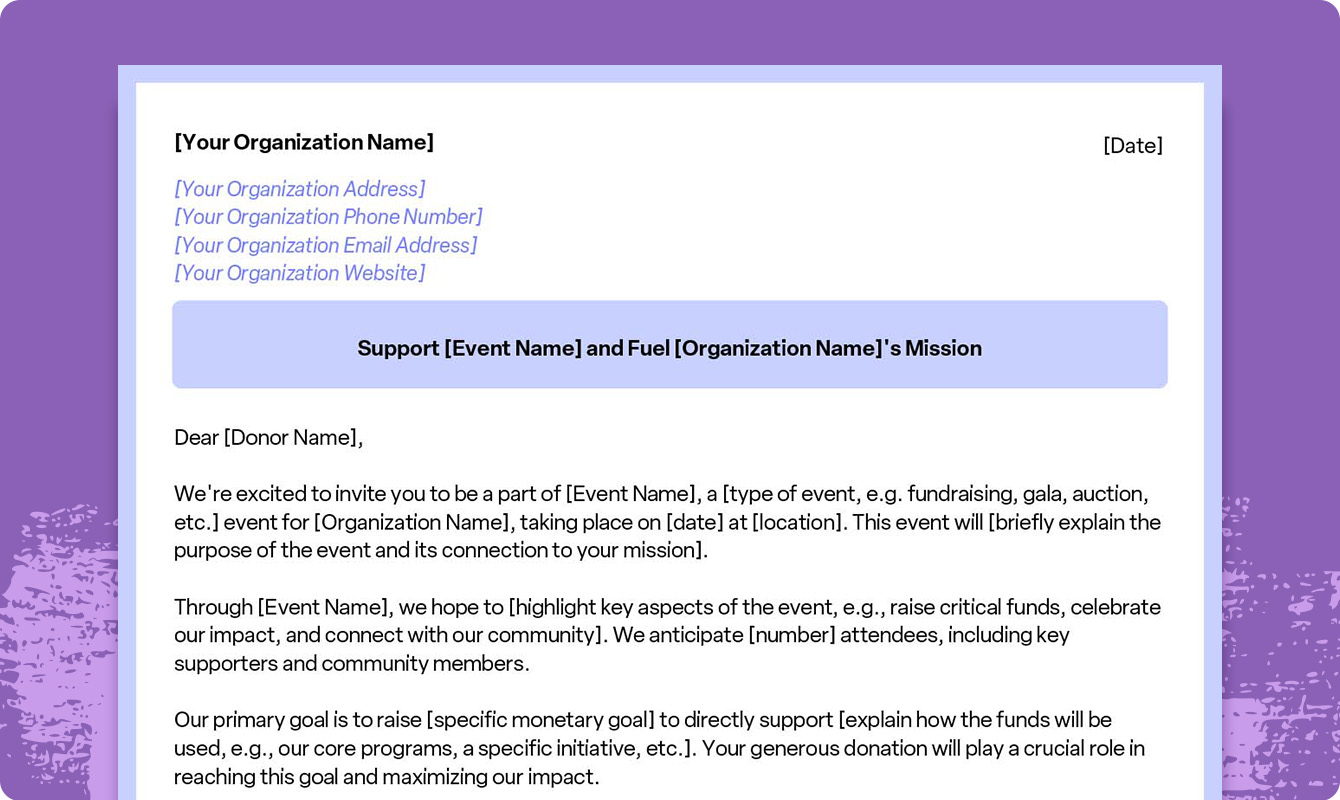
You can also provide additional benefits to individuals and businesses to entice contributions, such as complimentary tickets or placement on banners and other materials.
7. In-kind donation request letter
Monetary donations are always welcome, but you can also seek alternatives. Requesting in-kind donations can help your organization acquire essential supplies, resources, or services that you would otherwise need to purchase.
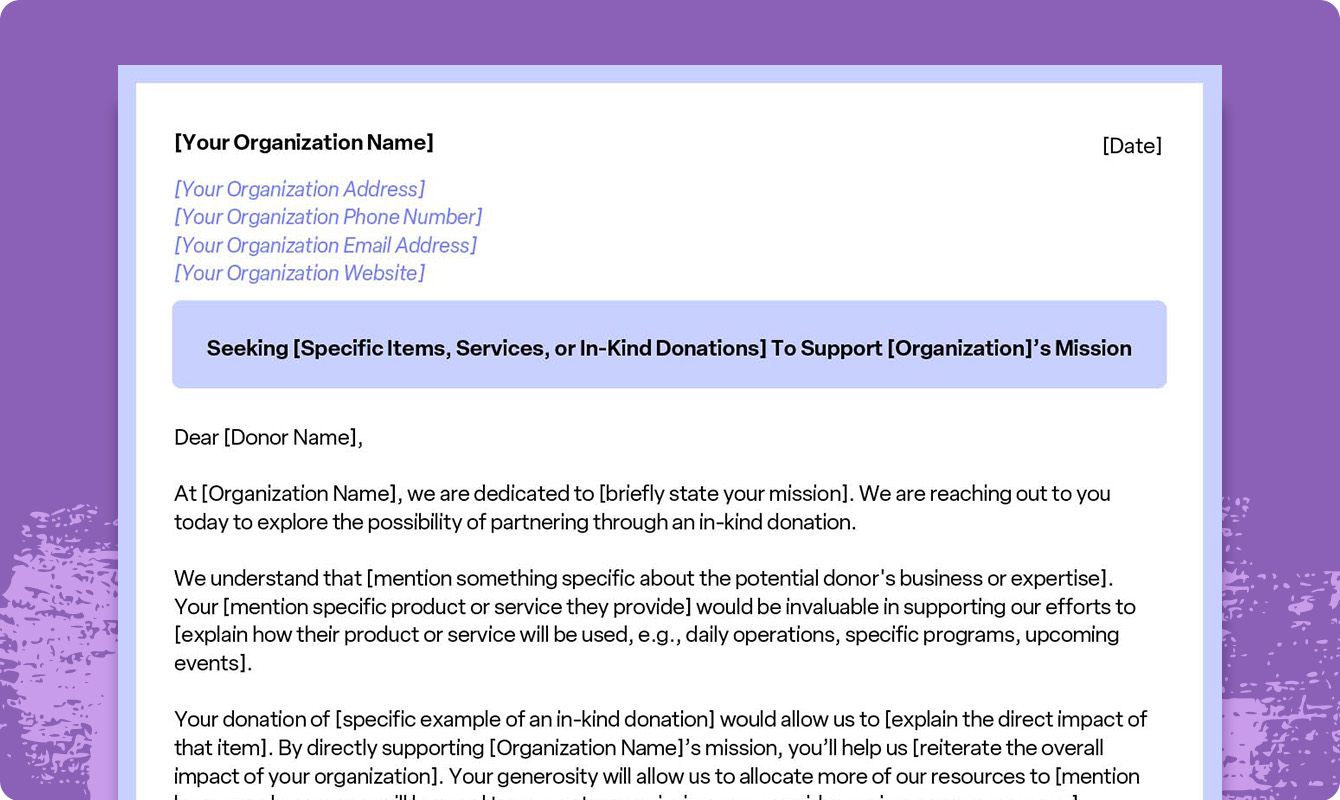
You might seek in-kind donations of toiletries, office supplies, or marketing services to better support your mission and sustain your day-to-day operations. Carefully consider who receives in-kind donation request letters; tailor each request to the individual or business to increase your chances of a positive reception.
8. School donation request letter
Nonprofit organizations aren’t the only ones who need to raise money; fundraising for schools is a year-round endeavor that requires careful planning and consistent effort.

Writing effective donation request letters means choosing the right recipients, such as alumni and parents of current students, and clearly explaining how your school plans to use the funds you raise.
9. Church fundraising letter
Encouraging donations from past and current members of the congregation, as well as other community members, can help churches provide community services, fund trips, or complete building renovations.

Warmth and gratitude are especially important in these fundraising requests. Most churches get the majority of their donations from their congregation, so in-person requests during regular gatherings can be instrumental in fundraising efforts.
10. Online donation request letter
Sending a short donation request message on social media, through email marketing, or via a text-to-give fundraising message can engage potential donors and simplify the donation process. Online donation requests are typically brief but engaging, with a clear call to action, making it quick and easy for recipients to donate.
Here are four examples of short messages you can send over text or social media to request donations.
| Message description | Sample message |
| Direct and mission-centric | Support [Organization Name]‘s mission to [briefly state core mission]. Your donation will directly impact our ability to [briefly state a key activity or outcome]. Click here to make a secure contribution now: [Shortened Donation Link] |
| Personalized narrative | Your gift helps [briefly mention a person or story, e.g., “Maria, a single mother, access essential resources”]. You can be part of their story by donating here: [Shortened Donation Link] |
| Timely and event-specific | Join us at [Event Name] and support our mission to [briefly state mission] by donating. Your contribution helps us [briefly state how donations will be used at the event]: [Shortened Donation Link] |
| Specific donation amount request | Just $10 can [short impact example, e.g., “provide a hygiene kit to an individual experiencing homelessness”]. Donate now to make it happen and directly [briefly describe how this donation will support your mission]: [Shortened Donation Link] |
11. Pledge campaign donation request letter
If you want to meet your pledge campaign goals, you’ll need timely, engaging donation requests. Make sure you emphasize specific initiatives and deadlines to encourage donors to act.
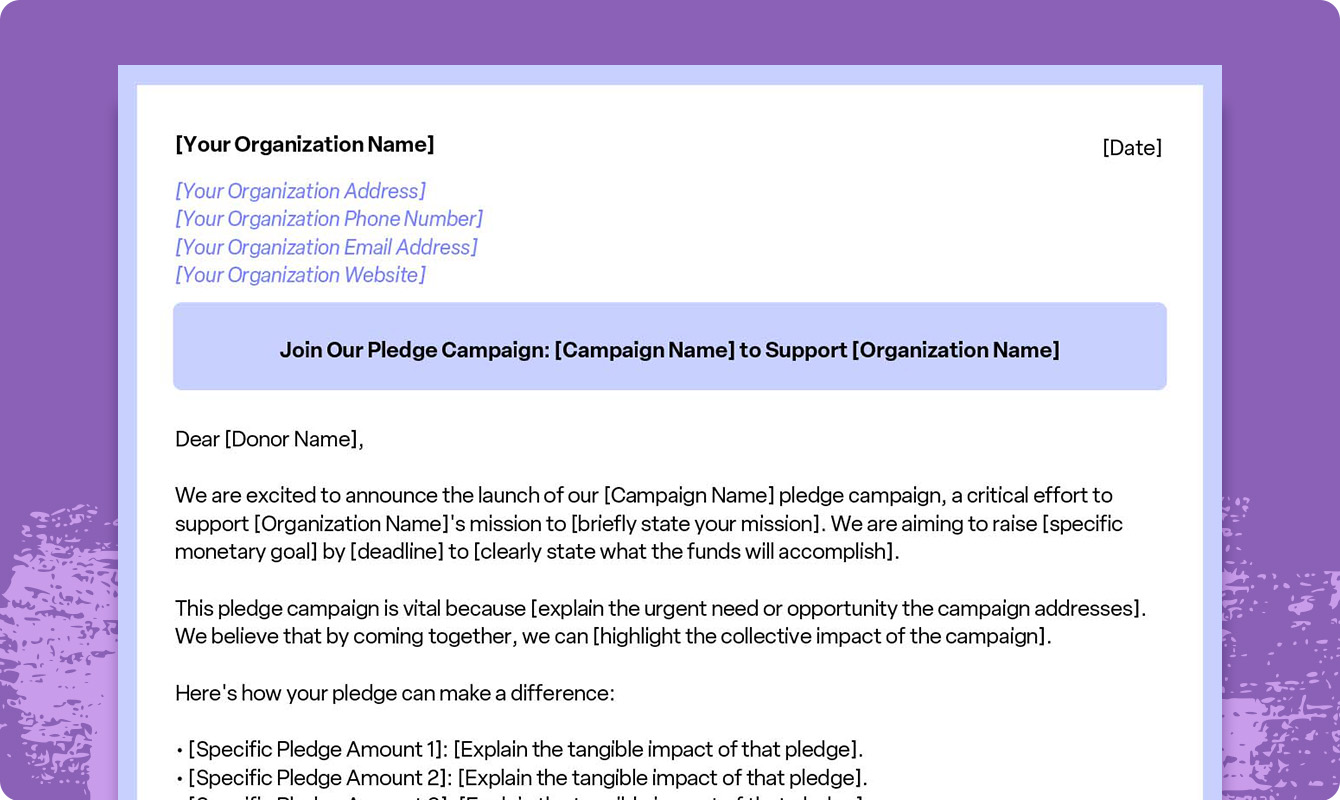
As with other donation letters, demonstrating your desired impact and creating an emotional connection can more effectively compel potential donors to participate.
12. Annual fund contributions request letter
A nonprofit organization’s annual fund helps support ongoing initiatives and expenses as they arise. Rather than acquiring donations for specific events or programs, requesting contributions to your annual fund can help your organization pay for building costs, salaries, and other miscellaneous expenses so you can focus on pursuing your mission.
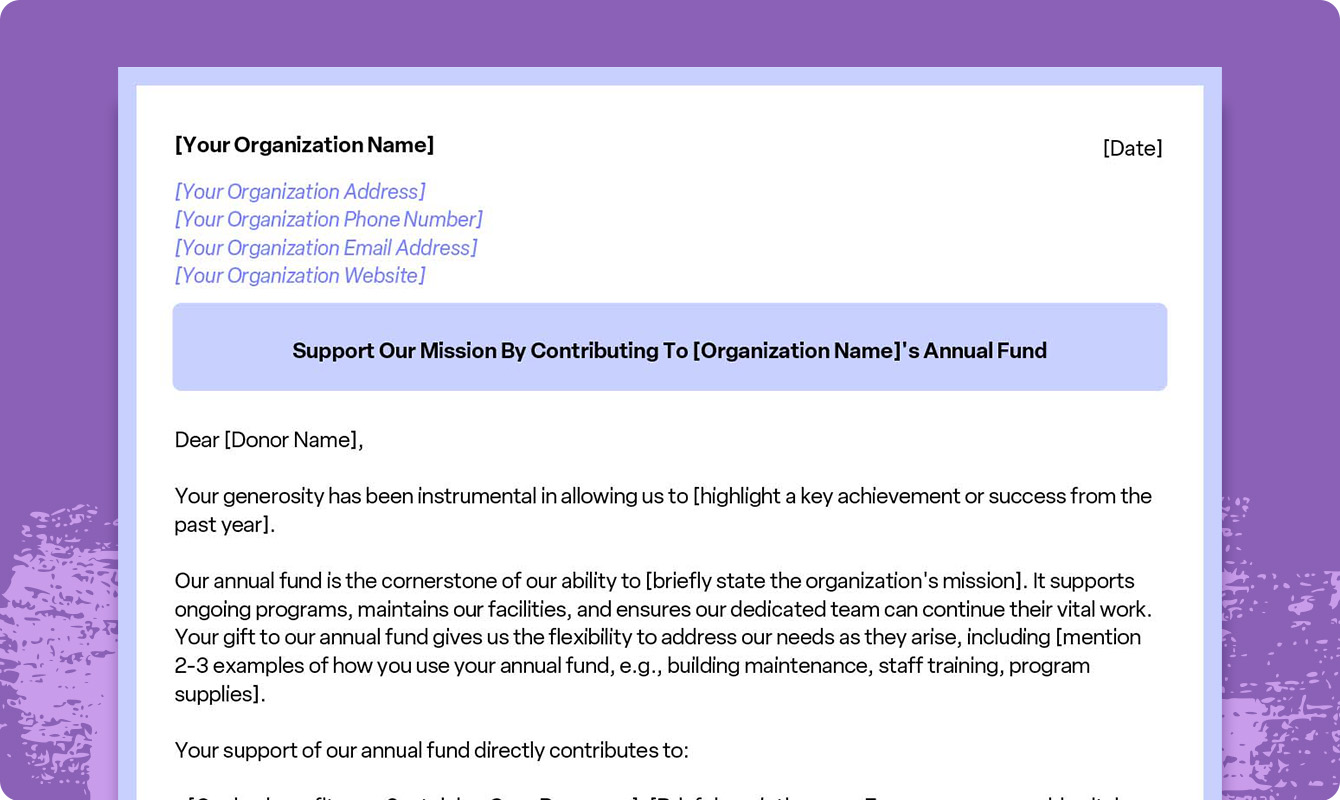
A compelling annual fund donation request may include:
- Heartwarming success stories
- Highlights from previous initiatives
- Measurable impact statistics
- Plans to demonstrate your organization’s charitable work
13. Matching gift request letter
One of the most effective ways to boost your fundraising revenue is to ask donors to take advantage of corporate matching gift programs — a popular corporate social responsibility (CSR) strategy.
Matching gifts is appealing to supporters because they can double the impact of their contribution without spending more of their own money.
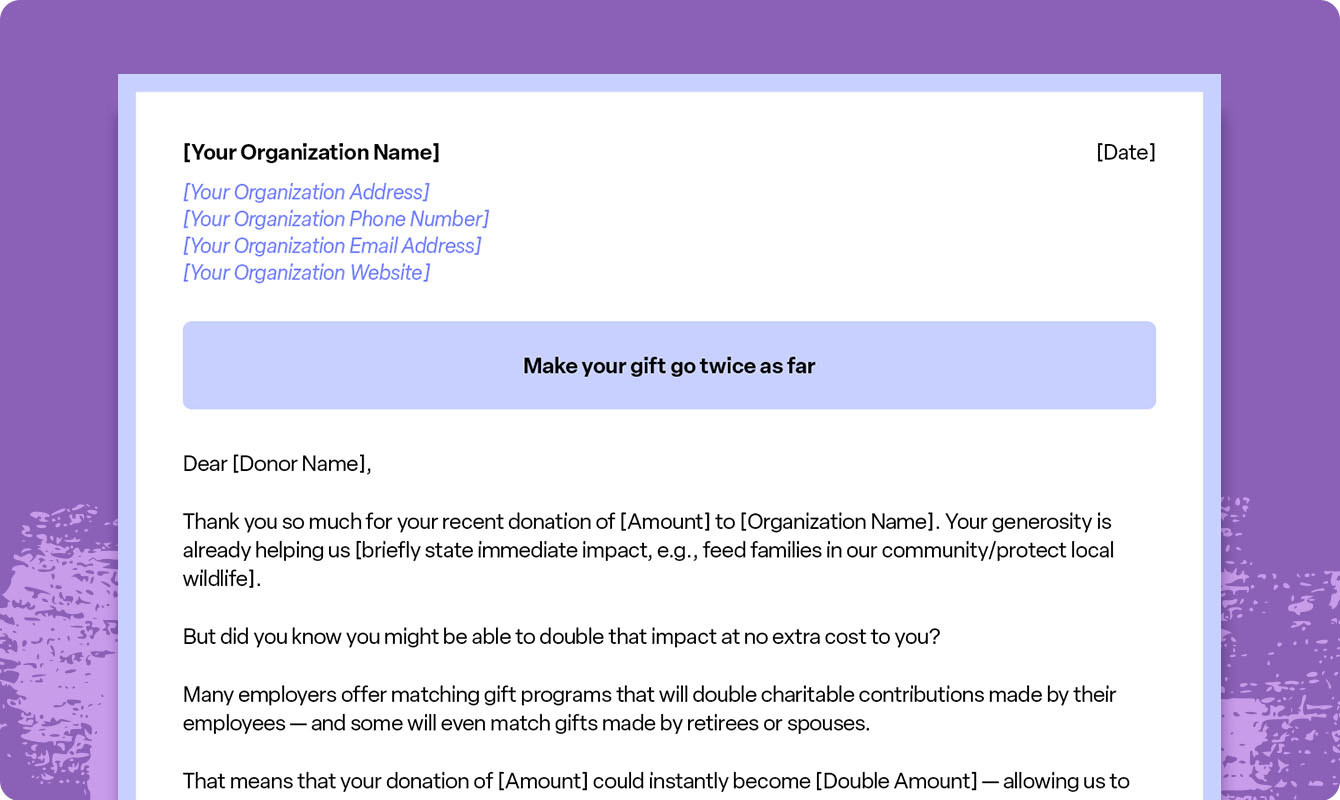
Educate your donors on how to submit a match request to their employers to easily increase the impact of their donation.
14. Peer-to-peer donation request letter
Peer-to-peer (P2P) fundraising transforms your supporters into your best advocates. Encourage them to reach out to their friends, family, and personal networks. This approach can give you access to a pool of potential donors who might never have found your organization otherwise.
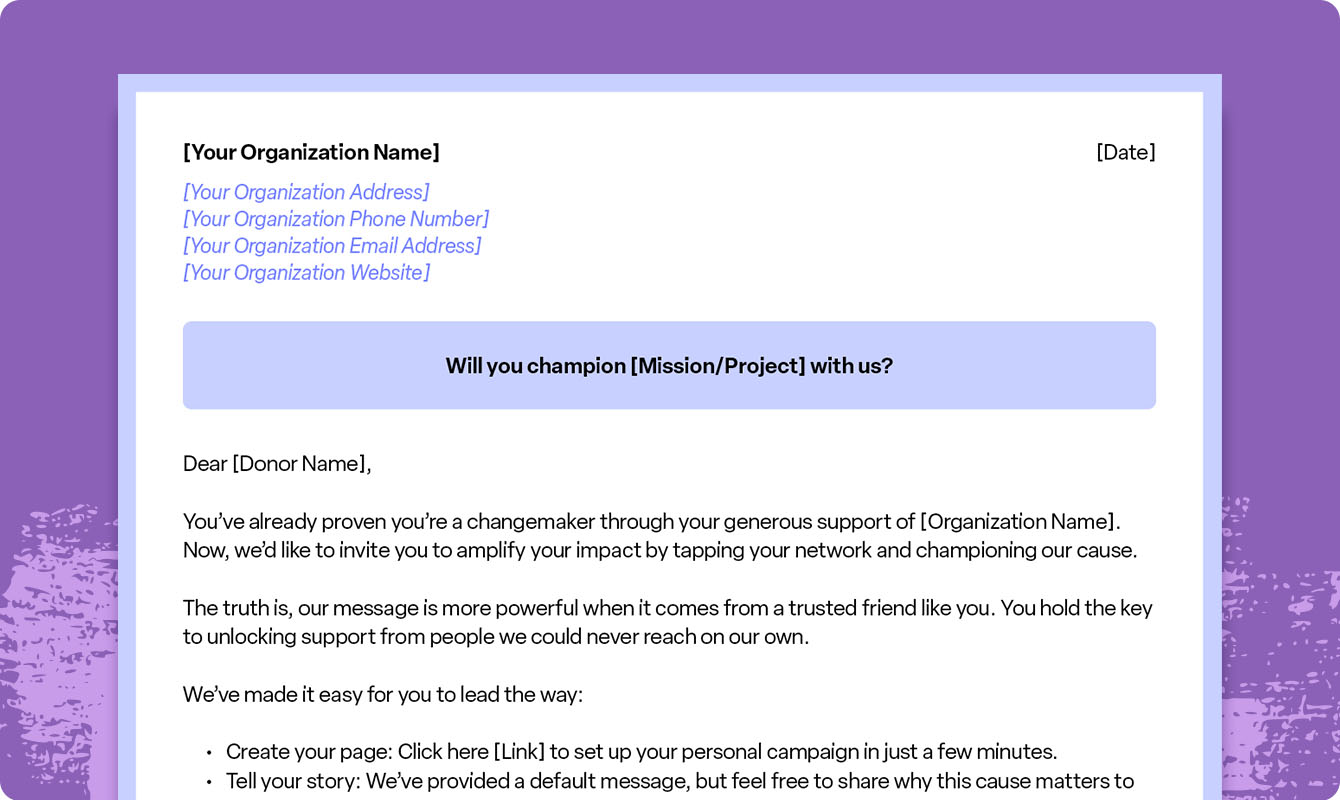
To make this strategy effective, you need to make the process as effortless as possible for your fundraisers. Empower your fundraisers to ensure they have the guidance to convey your mission and secure donations. You can also provide them with a pre-written template for donation requests to make their work easier.
Using a dedicated peer-to-peer platform like DonorDrive allows your champions to create seamless, shareable fundraising pages for better results.
As a bonus, you can include a pre-written message for your supporters to use when fundraising on your behalf. Sending this in your toolkit or the confirmation email after they sign up can help them feel more supported.
That message may look something like this:
| Subject line | Join me in supporting [Organization Name]! |
| Greeting | “Hi [Name]! As you may know, [Organization Name] is a cause close to my heart. |
| Body | This year, I’m stepping up to help them reach their goal of [Goal]. I’ve started a personal fundraiser to help [brief impact, e.g., provide 500 meals]. Any amount helps! |
| Call to action | You can support my campaign here: [Link to P2P Page]” |
15. Donor appreciation letter
Expressing sincere gratitude and telling donors how their contributions made an impact not only helps donors feel good but also encourages future donations.
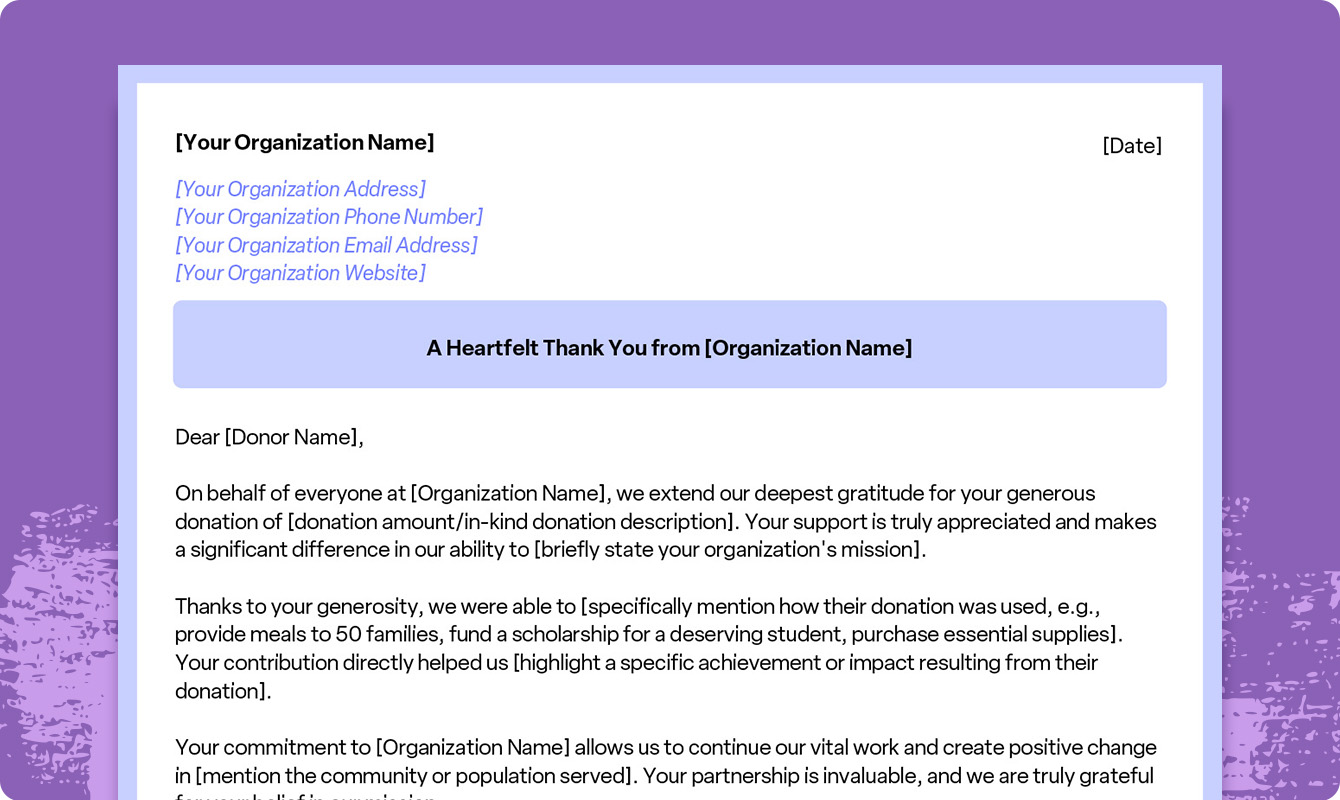
Memorable donor appreciation letters should reference how you used donations and the impact of those contributions to emphasize how your organization benefited from their generosity.
Boost donations with effective donation request letters
Taking the time to craft a personalized donation request letter is one of the highest-impact moves you can make for your nonprofit. By sharing your needs through compelling storytelling, you can offer donors a fresh perspective on your work and inspire more meaningful contributions.
An effective appeal must lead to a seamless online experience backed by high-quality donation page design — and robust nonprofit software to streamline your communications, donor management, and
Request a demo to see firsthand how investing in Bonterra’s fundraising software can help you maximize the impact of every letter and build the lasting donor relationships your organization needs.
FAQ
How do I write a letter asking for donations?
When writing a request for donations, include the following:
- A personalized greeting
- A description of your organization’s mission
- A compelling story of your work
- A description of the reason you’re requesting a donation
- A concise call to action
- A show of appreciation for their support
- Essential contact information for your organization
If you’re interested in applying for grants, including mental health grants for nonprofits, you can follow similar principles, though you’ll need to abide by specific application requirements, as well.
How do I write an in-kind donation request?
Specify exactly what your organization is looking for, whether it’s supplies, resources, food donations, or services.
It’s important to be selective in who you ask for in-kind donations — some individuals and businesses are better suited for certain requests than others.
What is an example of a short donation message?
Whether you’re following up on an initial donation request or sending a brief request through text messaging or social media, a short donation message should be concise and compelling with a clear call to action.
Some examples include:
- Can we count on your support? Donate to [Organization Name] today.
- Donate now to support [brief description of your mission or current initiative].
- Your donation can [brief description of impact, e.g., “feed a local family”]. Donate now.
What are the key elements of a donation request letter?
Regardless of the format or channel you choose to use, a successful donation request letter should always include:
- An engaging subject line or hook
- A personalized greeting
- A compelling story that connects the donor to your mission
- A specific request for support (the “ask”)
- A clear explanation of the donation’s impact
- A direct call to action with simple instructions on how to give
Work with Bonterra



